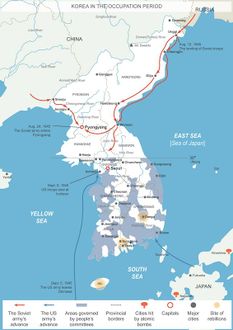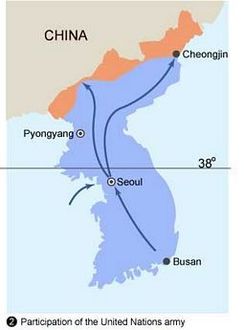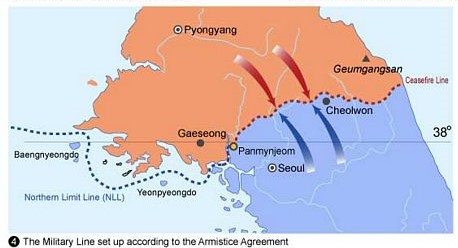The Division of Korea and the Korean War
On August 8, 1945, the Soviet Union declared war against waning Japan and began to deploy troops into the Korean Peninsula. A few days later on August 11, Japan announced its decision to surrender. The United States quickly sent some of its troops in order to prevent the Soviet occupation of the peninsula, but the Soviets occupied the northern part of Korea before their arrival. The U.S. and U.S.S.R. struck an agreement to use the 38th parallel as the line that divided Korea into Soviet and U.S. occupation zones.
The Soviet army immediately took control over at the 38th parallel by disconnecting the two railroads that had connected northern and southern Korea, and by September 6, postal and communication services across the parallel were disrupted. In other words, the Soviets established the 38th parallel which had originally meant to be an artificial buffer between the two occupation zones as a political and territorial border dividing those regions .
On June 25, 1950, the North Korean army crossed the 38th parallel and invaded the Republic of Korea. At the time, the North Korean army, supported by the Communist Soviet Union and China, was better equipped and trained than South Korean soldiers. As soon as the news of North Korean invasion reached the world, the United Nations Security Council held an emergency meeting, demanding North Korea to immediately cease any acts of aggression and dispatched a peacekeeping force to the Korean Peninsula.
However, the North Korean army soon occupied Seoul and pushed the South Korean army further south to the Nakdonggang River front where the two armies became locked in a stalemate. It was only when the Allied troops led by General MacArthur arrived in Incheon that South Korean forces could push the North Koreans back, and by September 28 they regained Seoul.
The tide was now turned. The North Korean troops began to retreat on all fronts. On September 29, President Rhee decided to pursue North Korea. As a result, the South Korean army crossed the 38th parallel and captured Pyeongyang on October 19. In desperation, North Korea asked for reinforcements from China and the Soviet Union, in response to which China sent more than 300,000 Chinese soldiers to fight the Korean War against the U.N. Forces led by the United States.
The war soon turned into a bloody stalemate at the 38th parallel, and after two years of that the U.N. and Communist forces came to the realization that there was no point in continuing the war and proposed a ceasefire to at least temporarily halt the conflict. Negotiations went on for two years while battles continued. The then newly-elected American president, Dwight Eisenhower, promised to end the war as resolutely and quickly as possible while on the contrary, the then South Korean president, Syngman Rhee, insisted that the war could not end until all Communists had been driven out of Korea. President Rhee also released around 36,000 anti-Communist prisoners in order to put a stop to the armistice talks. It was only after the U.N. promised that a mutual defence treaty would be concluded between South Korea and the U.S. and that long-term economic aid would be provided that Rhee agreed to conclude the armistice.
Even though the war was temporarily halted by the armistice, the damage it had caused remained tremendous. Around 1.19 million South Korean soldiers and U.N. peacekeeping forces were killed, missing-in-action, or injured. When adding civilian casualties, it is estimated that more than five million people from both Koreas lost their lives. Most industrial facilities and transportation infrastructure were ruined. However, the most devastating tragedy done by the war was that Koreans killed and injured their own compatriots, and since then the people of two Koreas have lived in mutual hostility towards one another.
Related Articles
- A New Dawn and the Night before a Storm - The Post-Liberation Period
- Douglas MacArthur
- Syngman Rhee
- Dwight Eisenhower
- United Nations Security Council
- Democratic People's Republic of Korea (North Korea)
- Republic of Korea (South Korea)
- Russia
- United States
- China
- Seoul
- Pyeongyang
- Nakdonggang River




